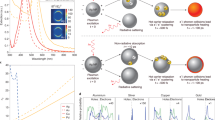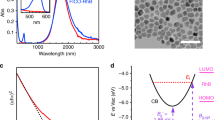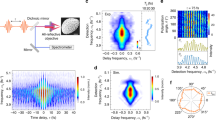Abstract
Light–matter interactions that induce charge and energy transfer across interfaces form the foundation for photocatalysis1,2, energy harvesting3 and photodetection4, among other technologies. One of the most common mechanisms associated with these processes relies on carrier injection. However, the exact role of the energy transport associated with this hot-electron injection remains unclear. Plasmon-assisted photocatalytic efficiencies can improve when intermediate insulation layers are used to inhibit the charge transfer5,6 or when off-resonance excitations are employed7, which suggests that additional energy transport and thermal effects could play an explicit role even if the charge transfer is inhibited8. This provides an additional interfacial mechanism for the catalytic and plasmonic enhancement at interfaces that moves beyond the traditionally assumed physical charge injection9,10,11,12. In this work, we report on a series of ultrafast plasmonic measurements that provide a direct measure of electronic distributions, both spatially and temporally, after the optical excitation of a metal/semiconductor heterostructure. We explicitly demonstrate that in cases of strong non-equilibrium, a novel energy transduction mechanism arises at the metal/semiconductor interface. We find that hot electrons in the metal contact transfer their energy to pre-existing free electrons in the semiconductor, without an equivalent spatiotemporal transfer of charge. Further, we demonstrate that this ballistic thermal injection mechanism can be utilized as a unique means to modulate plasmonic interactions. These experimental results are well-supported by both rigorous multilayer optical modelling and first-principle ab initio calculations.
This is a preview of subscription content, access via your institution
Access options
Access Nature and 54 other Nature Portfolio journals
Get Nature+, our best-value online-access subscription
$29.99 / 30 days
cancel any time
Subscribe to this journal
Receive 12 print issues and online access
$259.00 per year
only $21.58 per issue
Buy this article
- Purchase on Springer Link
- Instant access to full article PDF
Prices may be subject to local taxes which are calculated during checkout



Similar content being viewed by others
Data availability
The data that support the plots within this paper and other findings of this study are available from the corresponding author upon reasonable request.
References
Serpone, N. & Emeline, A. V. Semiconductor photocatalysis—past, present, and future outlook. J. Phys. Chem. Lett. 3, 673–677 (2012).
Kim, S. M., Hyosun, L. & Park, J. Y. Charge transport in metal-oxide interfaces: genesis and detection of hot electron flow and its role in heterogeneous catalysis. Catal. Lett. 145, 299–308 (2015).
Clavero, C. Plasmon-induced hot-electron generation at nanoparticle/metal-oxide interfaces for photovoltaic and photocatalytic devices. Nat. Photon. 8, 95–103 (2014).
Knight, M. W., Sobhani, H., Nordlander, P. & Halas, N. J. Photodetection with active optical antennas. Science 332, 702–704 (2011).
Asapu, R. et al. Electron transfer and near-field mechanisms in plasmonic gold-nanoparticle-modified TiO2 photocatalytic systems. ACS Appl. Nano Mater. 2, 4067–4074 (2019).
Chen, J. J., Wu, J. C., Wu, P. C. & Tsai, D. P. Improved photocatalytic activity of shell-isolated plasmonic photocatalyst Au@SiO2/TiO2 by promoted LSPR. J. Phys. Chem. C 116, 26535–26542 (2012).
Priebe, J. B. et al. Water reduction with visible light: synergy between optical transitions and electron transfer in Au–TiO2 catalysts visualized by in situ EPR spectroscopy. Angew. Chem. Int. Ed. 52, 11420–11424 (2013).
Yu, Y., Sundaresan, V. & Willets, K. A. Hot carriers versus thermal effects: resolving the enhancement mechanisms for plasmon-mediated photoelectrochemical reactions. J. Phys. Chem. C 122, 5040–5048 (2018).
Narang, P., Sundararaman, R. & Atwater, H. A. Plasmonic hot carrier dynamics in solid-state and chemical systems for energy conversion. Nanophotonics 5, 96–111 (2016).
Brongersma, M. L., Halas, N. J. & Nordlander, P. Plasmon-induced hot carrier science and technology. Nat. Nanotechnol. 10, 25–34 (2015).
Sundararaman, R., Narang, P., Jermyn, A. S., Iii, W. A. G. & Atwater, H. A. Theoretical predictions for hot-carrier generation from surface plasmon decay. Nat. Commun. 5, 5788 (2014).
Wu, K., Chen, J., McBride, J. R. & Lian, T. Efficient hot-electron transfer by a plasmon-induced interfacial charge-transfer transition. Science 349, 632–635 (2015).
Lin, Z., Zhigilei, L. V. & Celli, V. Electron–phonon coupling and electron heat capacity of metals under conditions of strong electron–phonon nonequilibrium. Phys. Rev. B 77, 075133 (2008).
Sachet, E. et al. Dysprosium-doped cadmium oxide as a gateway material for mid-infrared plasmonics. Nat. Mater. 14, 414–420 (2015).
Runnerstrom, E. L., Kelley, K. P., Sachet, E., Shelton, C. T. & Maria, J. P. Epsilon-near-zero modes and surface plasmon resonance in fluorine-doped cadmium oxide thin films. ACS Photon. 4, 1885–1892 (2017).
Runnerstrom, E. L. et al. Polaritonic hybrid-epsilon-near-zero modes: beating the plasmonic confinement vs propagation-length trade-off with doped cadmium oxide bilayers. Nano Lett. 19, 948–957 (2019).
Choi, G.-M., Wilson, R. B. & Cahill, D. G. Indirect heating of Pt by short-pulse laser irradiation of Au in a nanoscale Pt/Au bilayer. Phys. Rev. B 89, 064307 (2014).
Radue, E. L. et al. Hot electron thermoreflectance coefficient of gold during electron–phonon nonequilibrium. ACS Photon. 5, 4880–4887 (2018).
Giri, A. et al. Mechanisms of nonequilibrium electron–phonon coupling and thermal conductance at interfaces. J. Appl. Phys. 117, 105105 (2015).
Zhou, X. et al. Thin Ti adhesion layer breaks bottleneck to hot hole relaxation in Au films. J. Chem. Phys. 150, 184701 (2019).
Yang, Y. et al. Femtosecond optical polarization switching using a cadmium oxide-based perfect absorber. Nat. Photon. 11, 390–395 (2017).
Liu, C. P. et al. Effects of free carriers on the optical properties of doped CdO for full-spectrum photovoltaics. Phys. Rev. Appl. 6, 064018 (2016).
Nolen, J. R. et al. Ultraviolet to far-infrared dielectric function of n-doped cadmium oxide thin films. Phys. Rev. Mater. 4, 02520 (2020).
Giannozzi, P. et al. Quantum Espresso: a modular and open-source software project for quantum simulations of materials. J. Phys. Condens. Matter 21, 395502 (2009).
Giannozzi, P. et al. Advanced capabilities for materials modelling with Quantum Espresso. J. Phys. Condens. Matter 29, 465901 (2017).
Akimov, A. V. & Prezhdo, O. V. The PYXAID program for non-adiabatic molecular dynamics in condensed matter systems. J. Chem. Theory Comput. 9, 4959–4972 (2013).
Akimov, A. V. & Prezhdo, O. V. Advanced capabilities of the PYXAID program: integration schemes, decoherence effects, multiexcitonic states, and field-matter interaction. J. Chem. Theory Comput. 10, 789–804 (2014).
Acknowledgements
We acknowledge funding from the US Department of Defense, Multidisciplinary University Research Initiative through the Army Research Office, Grant no. W911NF-16-1-0406. J.R.N. and J.D.C. appreciate support from the Office of Naval Research, Grant no. N00014-18-1-2107.
Author information
Authors and Affiliations
Contributions
P.E.H. and J.-P.M. conceived the idea and supervised the project; J.A.T. performed the TDTR and infrared pump–probe measurements and corresponding analysis; E.L.R., K.P.K., J.N. and A.C. grew and characterized the CdO films; Y.-S.W., W.C. and O.V.P. performed the ab initio calculations; J.A.T. and D.H.O. performed the two-temperature model (TTM) calculations; J.A.T., J.R.N. and J.D.C. performed the transfer matrix method (TMM) calculations and provided insight on the dispersion relations. J.A.T. wrote the manuscript with input from all the authors; all the authors discussed the results and commented on the manuscript.
Corresponding author
Ethics declarations
Competing interests
The authors declare no competing interests.
Additional information
Peer review information Nature Nanotechnology thanks the anonymous reviewers for their contribution to the peer review of this work.
Publisher’s note Springer Nature remains neutral with regard to jurisdictional claims in published maps and institutional affiliations.
Supplementary information
Supplementary Information
Supplementary Discussion and Figs. 1–9.
Rights and permissions
About this article
Cite this article
Tomko, J.A., Runnerstrom, E.L., Wang, YS. et al. Long-lived modulation of plasmonic absorption by ballistic thermal injection. Nat. Nanotechnol. 16, 47–51 (2021). https://doi.org/10.1038/s41565-020-00794-z
Received:
Accepted:
Published:
Issue Date:
DOI: https://doi.org/10.1038/s41565-020-00794-z
This article is cited by
-
Bidirectional phonon emission in two-dimensional heterostructures triggered by ultrafast charge transfer
Nature Nanotechnology (2023)
-
Plasma-induced surface cooling
Nature Communications (2022)
-
Experimental characterization techniques for plasmon-assisted chemistry
Nature Reviews Chemistry (2022)
-
Off balance and over the edge
Nature Nanotechnology (2021)
-
Suppressed electronic contribution in thermal conductivity of Ge2Sb2Se4Te
Nature Communications (2021)



